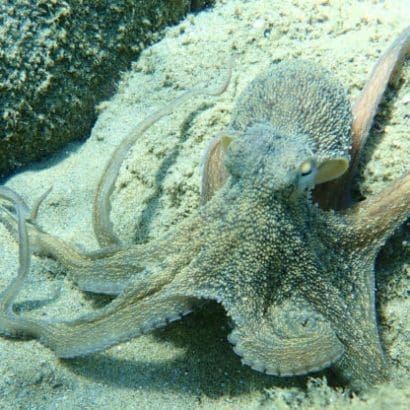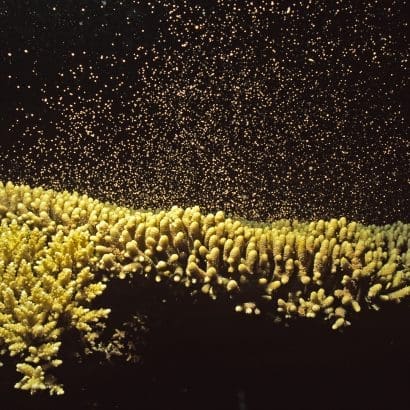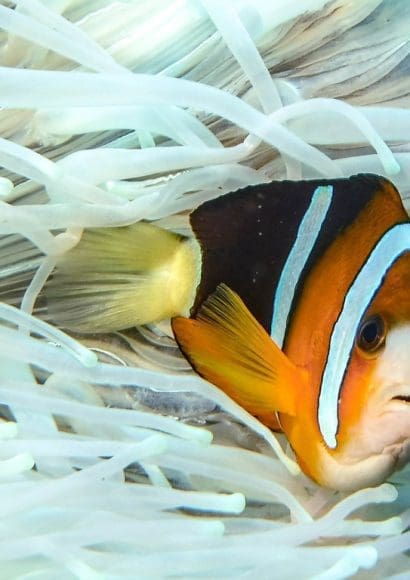
Would you like to know how a clownfish protects itself? Of course you do! Clownfish are like the superheroes of the ocean. They live in a special place called anemone, which is like a safe home for them. Do you know why? Well, anemones have tentacles that can sting other fish, but not clownfish! It’s as if they have a super armor against stings!
In addition, clownfish are very colorful, like orange and white. Do you know why this also helps them stay safe? Because when they swim close to the anemones, their colors blend in with the colors of the anemone! It’s like they’re disguising themselves to hide from big fish that might want to eat them.
So, to sum it up, clownfish protect themselves by living in an anemone, which gives them a safe place to stay, and they also camouflage themselves with their pretty colors to blend in with the anemone. They’re really smart and brave fish in the ocean!
Contents
Anatomy and Behavior of Clownfish.
Clownfish, also known as anemonefish, possess unique anatomical features and exhibit fascinating behavioral traits that contribute to their remarkable survival in the coral reef ecosystem. Understanding their anatomy and behavior sheds light on their adaptive strategies and symbiotic relationships.
Anatomy:
Clownfish typically have a small, compressed body with vivid colors, including shades of orange, yellow, and black, making them easily recognizable. Their bodies are covered in a layer of mucus, which provides protection against the stinging cells of their symbiotic host, the anemone. Additionally, they have a protective layer of specialized skin cells that reduce the impact of the anemone’s venomous tentacles.
One of the distinguishing features of clownfish is the presence of a hierarchical system based on size and dominance. They exhibit sexual dimorphism, meaning males and females have different physical characteristics. Males are generally smaller and possess a more aggressive behavior pattern compared to females.
Behavior:
Clownfish are known for their interesting behaviors, which contribute to their survival and protection within the coral reef environment. They form monogamous pairs and live within a specific anemone, establishing a mutually beneficial relationship.
The symbiotic relationship with anemones provides clownfish with protection from predators. They seek refuge within the anemone’s tentacles, as they are immune to the anemone’s toxins. In return, the clownfish help the anemone by providing it with nutrients through their waste products and by driving away polyp-eating fish.
Symbiotic Relationship with Anemones.
The relationship begins when clownfish establish their territory within the protective tentacles of anemones. The clownfish are immune to the stinging cells of the anemone, thanks to a special mucus layer on their skin. This provides them with a safe haven from potential predators. The anemones, in turn, benefit from the presence of the clownfish.
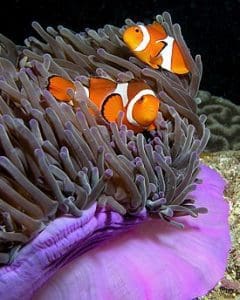
One of the key advantages for the anemones is that the clownfish help to provide nutrients. Clownfish produce waste that contains nitrogen-rich compounds, which the anemones can absorb and use as a source of food. This waste exchange nourishes the anemones, aiding in their growth and overall health.
Mechanisms of Protection in Clownfish.
Clownfish have developed several fascinating mechanisms of protection that enable them to thrive in the challenging environment of coral reefs. These strategies help them ward off potential predators and ensure their survival within the vibrant and sometimes perilous reef ecosystem.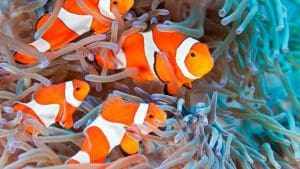
Camouflage is one of the primary mechanisms employed by clownfish. Their vibrant colors, such as shades of orange, yellow, and black, may seem counterintuitive for blending in, but within the intricate and colorful coral reef environment, they actually provide effective camouflage. The bright colors of the clownfish mimic the hues of the surrounding coral, making it difficult for predators to spot them among the reef’s diverse and vibrant backdrop.
Territorial behavior is another key defense mechanism of clownfish. They fiercely guard their chosen anemone and the immediate vicinity surrounding it. Through aggressive displays, including chasing, biting, and fin flaring, they deter intruders and protect their territory from other clownfish and potential threats. This territorial behavior serves as a warning to other fish, indicating that the area is already claimed and defended.
clownfish predator.🐟
Clownfish, also known as anemonefish, are fascinating creatures that inhabit the colorful world of coral reefs. One of the most interesting aspects of these small fish is how they cleverly protect themselves from potential predators. In this article, we’ll delve into the world of clownfish predators and discover the smart strategies these fish employ to ensure their safety.
- Natural Enemies of Clownfish Clownfish inhabit the same environment as many other ocean creatures, some of which may see them as a potential meal. Here are some common predators that clownfish have to watch out for:
- Eels: Moray eels are stealthy predators that can lurk near coral reefs, waiting for an opportunity to snatch a meal.
- Larger Fish: Larger fish, such as groupers and snappers, could see clownfish as a tasty snack.
- Sea Birds: Some sea birds, like herons and gulls, might try to grab clownfish swimming near the water’s surface.
- How Clownfish Protect Themselves Clownfish have developed several smart strategies to stay safe in their underwater homes. These techniques include:
- Anemone Partnership: One of the most famous clownfish protection methods is their symbiotic relationship with sea anemones. Clownfish have a special mucus on their skin that prevents the anemone’s stinging tentacles from harming them. They seek refuge among the tentacles, where predators can’t easily reach them.
- Camouflage: Clownfish are adorned with eye-catching colors, but these colors also serve as a form of protection. When swimming near their anemone home, their bright colors blend with the anemone’s hues, making it difficult for predators to spot them.
- Safe Nooks and Crannies: Clownfish are skilled at navigating through the nooks and crannies of the coral reef, using their small size to their advantage. They can quickly dart into crevices to escape larger predators.
Survival of the Cleverest Clownfish predators are always on the prowl, but these resourceful fish have evolved to outsmart them. By teaming up with anemones, using their vibrant colors to blend in, and skillfully maneuvering through their coral surroundings, clownfish have secured their place as survivors in the ocean’s intricate food web.
Communication and Warnings.
Communication plays a crucial role in the lives of clownfish, enabling them to establish social bonds, defend territories, and communicate warnings to intruders. These fascinating fish utilize a combination of visual displays, body language, and chemical signals to convey important messages within their community and ensure their safety within the coral reef environment.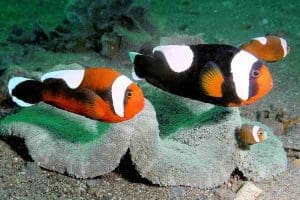
Visual communication is an essential aspect of clownfish behavior. They exhibit various body postures and color changes to convey different messages to other fish. For instance, when a clownfish is feeling threatened or aggressive, it may flare its fins, expand its body size, and display darkened colors as a warning to potential intruders. Conversely, when a clownfish is calm and at ease, it may adopt a more relaxed posture and exhibit lighter, vibrant colors.
Body language also plays a significant role in communication among clownfish. They use specific movements, such as swimming patterns and gestures, to convey messages to their companions. For example, a quick, darting swim towards an intruder is a clear warning sign, indicating that the territory is already occupied and defended by the clownfish.
how do clownfish protect themselves.🐟
One of the ways clownfish protect themselves is by living in very special homes called anemones. Anemones might look dangerous because they have tentacles that can sting other fish. However, clownfish have a kind of special layer on their skin that makes them immune to these stings. So, to a predator that wants to eat a clownfish, the anemones might seem like a dangerous house with poisonous tentacles, but they’re actually a safe haven for the clownfish!
Furthermore, the bright colors of clownfish, like orange and white, also help them stay protected. When they swim close to the anemones, their colors blend in with the anemones’ colors. This makes it harder for other predator fish to see them. It’s like the clownfish are camouflaging or disguising themselves – which is really clever!
In summary, clownfish protect themselves by living in anemones, where the tentacles don’t harm them thanks to their special layer. They also hide by using their bright colors to blend in with their anemone home. So, even though they’re small, these fish have some big tricks to stay safe in the exciting world of the ocean.”
Physical Adaptations.
Clownfish have evolved several remarkable physical adaptations that enable them to thrive in their unique coral reef habitat. These specialized features enhance their survival, movement, and interaction within the complex underwater ecosystem.
One of the notable physical adaptations of clownfish is their slim, laterally compressed bodies. This streamlined shape allows them to navigate through the narrow crevices and intricate coral structures within the reef with ease. The slender body form reduces drag and enables swift and agile movement, making them well-suited for maneuvering through their complex environment.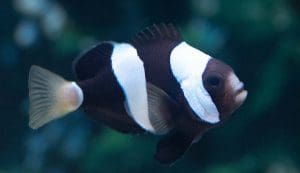
Clownfish possess a protective layer of mucus on their skin, which serves multiple purposes. This mucus layer acts as a defense against the stinging cells of the anemone they inhabit, providing them with immunity to the anemone’s toxins. It also aids in camouflage by blending the clownfish’s body colors with the surrounding coral, further enhancing their ability to hide from potential predators.
Threats and Conservation.
In conclusion, clownfish face various threats in their natural habitat, the coral reefs, which necessitate conservation efforts to ensure their long-term survival. One significant threat is habitat destruction caused by human activities such as overfishing, pollution, and destructive fishing practices. These activities can damage the coral reefs, disrupting the delicate balance that clownfish rely on for food, shelter, and reproduction.
Another threat to clownfish populations is climate change. Rising ocean temperatures and ocean acidification associated with climate change have detrimental effects on coral reefs, leading to coral bleaching and reduced coral growth. This loss of coral habitat directly impacts clownfish, as their dependence on anemones and the reef ecosystem is compromised.
Conservation efforts play a crucial role in safeguarding clownfish and their fragile coral reef habitat. Protecting marine protected areas and implementing sustainable fishing practices are essential steps in preserving the biodiversity and integrity of the reefs. Educating local communities, fishermen, and tourists about the importance of sustainable practices and responsible tourism can contribute to the conservation of clownfish and their habitats.

